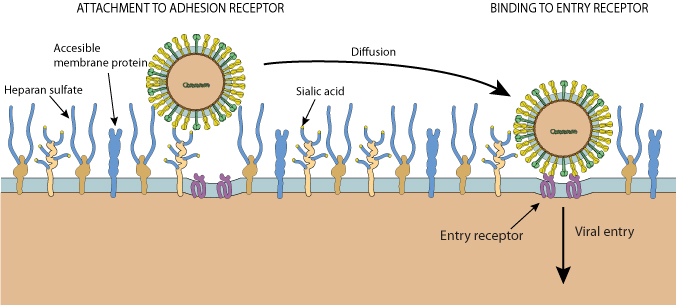Viral attachment to host entry receptor (kw:KW-1234)
Entry receptors trigger virus entry by endocytosis/pinocytosis or by inducing fusion/penetration. The consequences of this binding are irreversible. They have often be named "co-receptors". Entry receptors are often difficult to access for the virion, which circumvents this problem by binding first to adhesion receptors, which increases the probability of binding to the entry receptor.

In herpesviruses for example, gC makes the primary contact with the host cell surface, binding to heparan sulfate proteoglycans. Binding of gD to the entry receptors induces viral fusion to the host cell membrane and viral penetration
 .
.
In bacterial viruses, attachment to the entry receptor is often referred to as irreversible adsorption, based on experimental observations  .
.
Rakhuba DV, Kolomiets EI, Dey ES, Novik GI
Pol J Microbiol. 2010;59(3):145-55
Heldwein EE, Krummenacher C
Cell Mol Life Sci. 2008 Jun;65(11):1653-68
Matching UniProtKB/Swiss-Prot entries
(all links/actions below point to uniprot.org website)141 entries grouped by protein
9 entries
Pro-secreted protein ORF2 (Protein ORF2) (pORF2)
2 entries
Envelope glycoprotein (Env polyprotein)
1 entry
Short tail fiber protein gp12 (Gene product 12) (gp12)
1 entry
Tail spike protein (TSP) (Gene product 21) (Gp21)
9 entries
Fusion glycoprotein F0
9 entries
Attachment protein G3P (Gene 3 protein) (G3P) (Minor coat protein)
19 entries
Envelope glycoprotein D (gD)
2 entries
Envelope glycoprotein E (gE)
3 entries
Envelope glycoprotein H (gH)
12 entries
Envelope glycoprotein L (gL)
8 entries
Glycoprotein
1 entry
Glycoprotein G
7 entries
Envelopment polyprotein (M polyprotein)
2 entries
Glycoprotein Q1 (gQ1) (Glycoprotein 105) (gp105) (Glycoprotein Q-80k) (gQ-80k) (HCLF1 protein)
1 entry
Glycoprotein Q2 (gQ2) (Glycoprotein Q-37k) (gQ-37k)
5 entries
Genome polyprotein
28 entries
Structural polyprotein (p130)
2 entries
Receptor binding protein (RBP) (Gene product 18) (Gp18)
1 entry
Receptor-binding protein pb5 (RBP-pb5) (Tail protein pb5)
1 entry
Spike protein (Baseplate assembly protein gpV) (Gene V protein) (GpV)
2 entries
Tip attachment protein J (Central tail fiber) (CTF) (gpJ protein)
1 entry
Protein UL131A
2 entries
Envelope protein UL128
2 entries
Envelope glycoprotein UL130
11 entries
